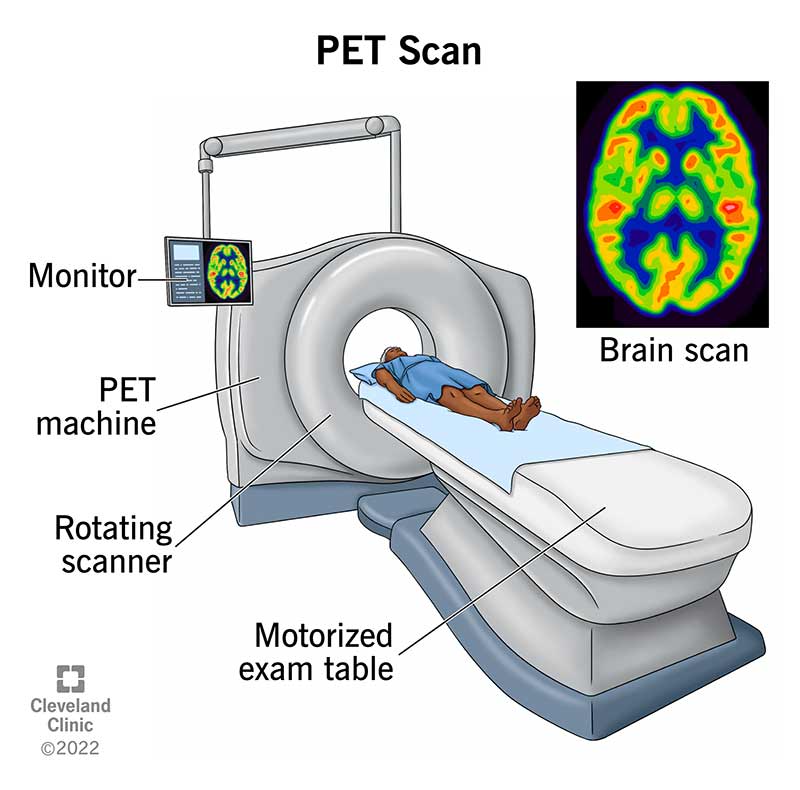Positron emission tomography (PET) scans detect early signs of cancer, heart disease and brain conditions. It involves an injection of a safe radioactive tracer that helps detect diseased cells.
Advertisement
Cleveland Clinic is a non-profit academic medical center. Advertising on our site helps support our mission. We do not endorse non-Cleveland Clinic products or services. Policy

A positron emission tomography (PET) scan is an imaging test that produces images of your organs and tissues at work. The test uses a safe, injectable radioactive chemical called a radiotracer and a device called a PET scanner.
Advertisement
Cleveland Clinic is a non-profit academic medical center. Advertising on our site helps support our mission. We do not endorse non-Cleveland Clinic products or services. Policy
The scanner detects diseased cells that absorb large amounts of the radiotracer, which indicates a potential health problem.
Healthcare providers frequently use PET scans to help diagnose cancer and assess cancer treatment. They can also assess certain heart and brain issues with the scan.
Computed tomography (CT) scans use X-rays. Magnetic resonance imaging (MRI) scans use magnets and radio waves. Both produce still images of organs and body structures.
PET scans use a radioactive tracer to show how an organ is functioning in real time. PET scan images can detect cellular changes in organs and tissues earlier than CT and MRI scans. Your healthcare provider may perform a PET scan and CT scan at the same time (PET-CT). This combination test produces 3D images that allow for a more accurate diagnosis.
Some hospitals now use a hybrid PET/MRI scan. This new technology creates extremely high-contrast images. Providers mainly use this type of scan for diagnosing and monitoring cancers of the soft tissues (brain, head and neck, liver and pelvis).
Your healthcare provider may order a PET scan to check for signs of:
Advertisement
In general, a PET scan can measure vital functions, such as blood flow, oxygen use and blood sugar (glucose) metabolism. It can also identify organs and tissues that aren’t working as they should.
If your healthcare provider suspects you may have cancer, they’ll likely recommend a PET scan, which can detect cancer and/or make a diagnosis.
If you’ve already been diagnosed with cancer, your provider may recommend more than one PET scan throughout your treatment to:
If you’re having heart issues, your provider may recommend a PET scan to:
If you’re experiencing neurological symptoms, your provider may recommend a PET scan to evaluate possible brain abnormalities, such as tumors, seizures and other central nervous system conditions.
A PET scan is a type of nuclear medicine imaging. Nuclear medicine uses small and safe amounts of radioactive material, called radiotracers, given through an IV.
Unlike other imaging techniques, PET scans focus on processes and molecular activity within your body. This gives them the potential to find disease in its earliest stages.
Diseased cells in your body absorb more of the radiotracer than healthy ones do. These are called “hot spots.” The PET scanner detects this radiation and produces images of the affected tissue. A PET/CT scan combines X-ray images from a CT scan with PET scan images.
PET scans are an outpatient procedure, which means you go home the same day. Your healthcare provider will give you detailed instructions on how to prepare for the scan. In general, you should:
Advertisement
You can expect the following during a PET scan:
The entire PET scan process takes about two hours.
It can take up to 60 minutes for your body to absorb the injected radiotracer. During this time, you’ll need to sit quietly and limit your movements. The actual PET scan takes about 30 minutes. After the test, you’ll need to wait while the technologist reviews the scans to ensure the images are clear.
Advertisement
In general, PET scans are safe and rarely cause problems. The amount of radiation in the radioactive tracer is very low. It doesn’t stay in your body for long. You should drink lots of water after a PET scan to help flush the radioactive drug from your body.
PET scans generally only pose risks in the following situations:
A radiologist with specialized training in PET scans will review the images, write a report and send it to your healthcare provider. This process usually takes 24 hours.
A positron emission tomography (PET) scan is a very useful and generally safe imaging test that healthcare providers use to assess cancer, heart issues and brain conditions. If you need a PET scan and are worried about the exam or have questions about it, don’t be afraid to ask your healthcare provider. They’re available to help and support you.
Advertisement
When you need a clear picture of what’s happening inside your body, the Cleveland Clinic imaging team is here for you.

Last reviewed on 10/19/2022.
Learn more about the Health Library and our editorial process.